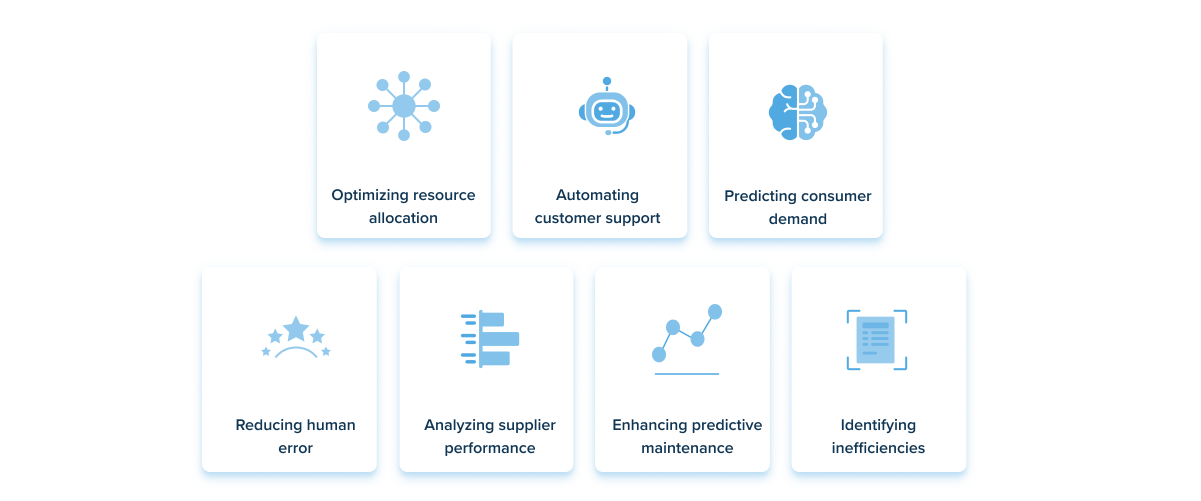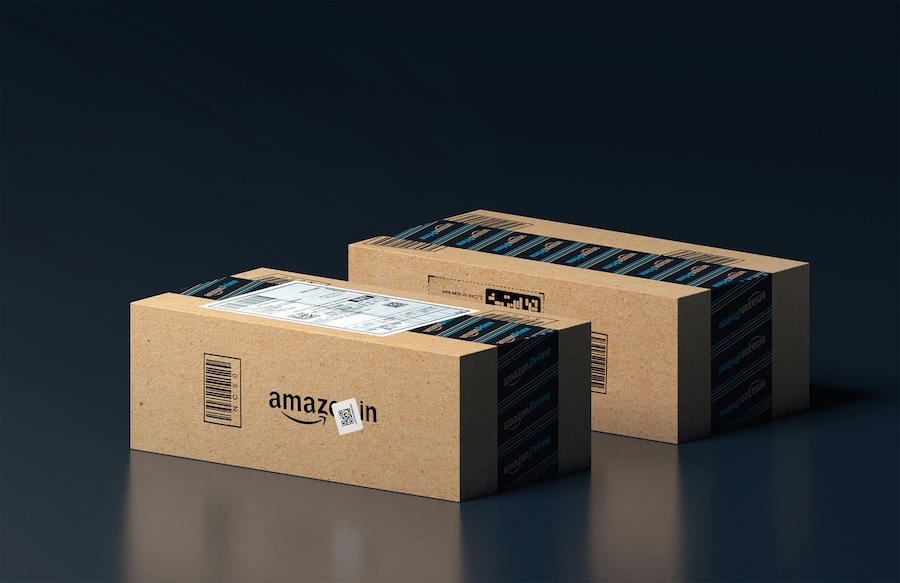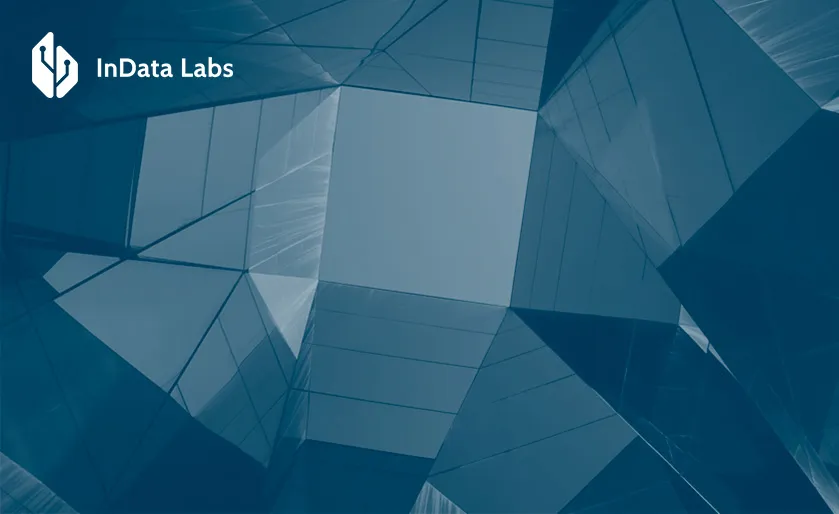Artificial intelligence (AI) has become an integral part of doing business, with applications across most industries. The synergy between human expertise and AI efficiency can drive innovation while reducing operational costs.
According to McKinsey’s State of AI report, 50% of companies use AI-enabled technology in at least one business area. The study also looked at the impact of AI in cost reduction, reporting significant savings in some industries and sectors.
In supply chain management, 41% of respondents saw a cost reduction of 10% to 19% after implementing AI. Around 20% of marketing and sales teams, 32% of manufacturing departments, and 25% of HR leaders had similar cost savings.
Additionally, 63% of enterprises have also experienced revenue increases of up to 10% or more. For example, 41% of marketing and sales teams and 33% of manufacturing departments have generated 6 to 10% higher revenues following AI adoption.
But how does AI reduce costs? And which industries can benefit most from it? Let’s find out.
How AI can help companies cut costs
OpenAI’s Chat GPT, Google Gemini (formerly Bard), and similar tools have been on everyone’s minds over the past few years. These platforms use generative AI to produce text, images, videos, and other types of content.
McKinsey’s latest report, The State of AI in 2023, found that 33% of businesses use gen AI tools to cut costs. Another 12% reported using this technology to create new income streams. For instance, the Associated Press leverages generative AI to create news reports. Not only does this strategy help reduce costs, but it also allows reporters to save time on research and streamline repetitive tasks.

Source: Unsplash
However, this technology is just one subset of artificial intelligence. There’s also machine learning, deep learning, computer vision, neural networks, natural language processing (NLP), and more.
Companies can use these AI systems to detect fraud, create better products, and automate their operations. Take deep learning, for example. This branch of AI enables enterprises to cut costs by:

A 2023 study by Statista assessed the impact of artificial intelligence on cost reduction in eight business areas.
The sectors that seem to benefit most from AI adoption include manufacturing, service operations, and marketing and sales. Around 4% of all companies saw cost savings of at least 20%, and 28% lowered their costs by 10% or less after adopting AI. One-tenth of enterprises experienced cost reductions of 10 to 19%.
These findings align with the results of McKinsey’s report, confirming AI’s cost-saving potential. Fortune magazine goes as far as calling this technology “the holy grail of cost reduction for CFOs”—and for good reason.
AI cost reduction: Real-world examples
Microsoft, Tesla, IBM, Amazon, and other successful brands leverage AI to keep costs low and stay at the forefront of innovation. For instance, Tesla uses artificial intelligence to collect data from its vehicles. These insights allow the company to continuously improve its products, optimize energy usage, and address issues early in the production process.
Additionally, Tesla factories deploy AI-powered robots to automate manufacturing processes and manual tasks. The result? Faster time to market, higher accuracy, increased efficiency, and lower costs. But startups and small businesses can benefit from AI, too.
Here are some other real examples of how AI has reduced operating expenses.
Airbnb
Airbnb uses artificial intelligence to generate listing summaries, analyze guest behavior, and make custom recommendations. Moreover, its AI-powered chatbots are available 24/7, guiding customers through the booking process.
The travel platform also leverages this technology to weed out fake profiles and protect users from spam. Its dynamic pricing strategy is powered by AI, too. For example, rental rates may increase or drop based on seasonal demand.
These features enable Airbnb to cut overhead and operational costs, maximize revenue, and deliver personalized experiences.

Source: Unsplash
WPP
WPP, a global creative agency based in London, deploys generative AI to create stunning ads. Its AI-powered tools allow top brands like Nestle and Mondelez to cut marketing costs and expand their reach.
For example, the agency used AI to virtually recreate an African landscape for a commercial shoot instead of dispatching a film crew to that respective location. “The savings can be 10 or 20 times,” according to WPP’s CEO, Mark Read.
Amazon
Another example comes from the tech giant Amazon, which uses AI-powered algorithms to optimize costs and deliver outstanding service. Let’s say you place an order on the platform. Amazon will check your location and traffic data to identify the most efficient delivery routes. This step alone allows the company to cut costs and expedite shipping.
Some Amazon factories also use AI-driven robots to pack and ship orders, resulting in lower overhead costs and higher efficiency. Moreover, its marketing teams employ AI to display personalized product recommendations based on factors like:
- Buyer’s location
- Browsing history
- Purchase behavior
- Trending products.

Source: Unsplash
This approach enables Amazon to delight customers, drive repeat sales, and maximize marketing spend. In some cases, it may reduce the likelihood of product returns—and the associated costs.
Ralph Lauren
Ralph Lauren and other fashion brands use predictive intelligence to create products that resonate with their customers. These AI-driven insights allow them to better understand consumer preferences and forecast product demand.
Predictive analytics data is invaluable to product design, manufacturing, and marketing operations. Not only does it enable companies to create products that sell, but it also guides their sales efforts.
Over time, this technology can reduce manufacturing costs and boost profits. Plus, it often leads to increased customer satisfaction and loyalty. Ralph Lauren also uses generative AI to streamline content creation and other marketing activities. This initiative is part of its efforts to keep up with the latest technology and reach more customers online.
How does AI improve efficiency?
Investment in AI is on a massive rise, and predicted to reach $200 billion globally by 2025. This is because the efficiency of artificial intelligence is able to disrupt traditional business models, opening up new opportunities.
Let’s see how businesses can leverage the efficiency of AI.
Generative AI’s efficiency in customer service
According to McKinsey, about 75% of the value delivered by gen AI lies in four main areas, including:
- Customer operations
- Research and development (R&D)
- Software engineering
- Marketing and sales.
To begin, enterprises can tap into generative AI’s efficiency to automate and streamline customer operations such as customer service. In a recent survey, 88% of consumers reported having at least one conversion with a chatbot. Nearly 70% were satisfied with their experience. Moreover, chatbots can cut customer support costs by up to one-third while increasing conversions. And they’re often faster and more efficient than human agents.
This technology can also retrieve customer data, helping human agents provide more accurate answers. Moreover, it can make personalized recommendations based on that data, which may increase sales.
Additionally, gen AI is capable of turning customer data into actionable insights. For example, it can identify the most common customer queries and complaints. You can use this data to create a knowledge database or FAQ section, improve your products, or optimize your services.
These features can boost customer service productivity by up to 45%, notes McKinsey. In one study, companies experienced a 9% decrease in the time spent handling complaints upon AI adoption.

Source: Unsplash
AI’s role in research and development
When it comes to R&D, businesses can integrate AI to enhance innovation, accelerate time-to-market, and stay competitive in rapidly evolving markets. Here are a few specific ways research and development departments can reap the benefits of AI:
- Natural language processing: We’ve mentioned NLP before, but in R&D this technology enables workers to quickly analyze unstructured data from research papers, patents, and customer feedback to identify valuable insights, emerging trends, and areas for innovation.
- Predictive modeling: AI algorithms can be used to create predictive models that forecast market trends, customer preferences, and potential outcomes of R&D initiatives.
- Rapid discovery: In industries like pharmaceuticals, for example, AI is already used for drug discovery, molecular modeling, and clinical trial optimization because of how quickly it can analyze biological data, identify potential drug candidates, and predict efficacy and safety.
- Automated experiments: AI can even automate the simpler elements of laboratory experiments, accelerating the R&D process and reducing costs. For example, robotic systems controlled by AI algorithms can conduct experiments, analyze results, and generate insights.
Software engineering and AI
Many developers are likely already using AI to support their day-to-day tasks. Before long, many larger businesses (that haven’t already) will likely implement AI into everyday workflows to help develop and maintain internal technology.
Aside from quickly generating snippets of code to help devs get work done faster, AI is already pretty proficient at automated testing to identify areas prone to failure and sussing out bugs. In some cases, it can even debug on its own. On the maintenance side, AI can run analysis to predict maintenance needs and even be deployed against user behavior to catch opportunities for improvement and identify future requirements.

Source: Unsplash
Using AI for sales efficiency and marketing
Artificial intelligence can streamline every step of the sales process, from lead generation to follow-up support. It’s also capable of forecasting sales, identifying high-value leads, and onboarding new customers.
Here are a few examples of how companies are using AI for sales efficiency:

For example, online marketplaces like Amazon and Alibaba leverage deep learning, NLP, and chatbots to analyze customer needs. This data allows them to forecast sales and customer demand, recommend relevant products, and optimize inventory levels. They also implement dynamic pricing on product pages based on insights from data analysis.
Additionally, AI can significantly enhance marketing efficiency, again largely through the automation of repetitive tasks, including:
- Gathering and analyzing customer data across channels
- Using data to create accurate customer profiles
- Identifying new trends and patterns (before competitors can even jump on them)
- Creating and managing robust campaigns, from content development to A/B testing, running marketing analytics reports, and optimization.
Furthermore, AI-driven chatbots can also be used in a marketing application to personalize experiences and funnel consumers into the right journey to drive engagement and, ultimately, higher conversion rates.
Embrace AI for energy
By using AI for energy efficiency, companies can reduce their energy bills. The impact of artificial intelligence on energy efficiency also translates to a lower carbon footprint, helping enterprises with their efforts to go green.
Here are some ways businesses can use AI for energy efficiency:
- Detect anomalies in energy consumption
- Enable intelligent control for HVAC and refrigeration systems
- Optimize building management systems
- Predict energy consumption
- Improve grid performance.
For example, businesses can leverage AI to increase the efficiency of HVAC systems. These can be connected to AI-powered apps to adjust temperature settings and airflow in real time, reducing energy usage.
Siemens, Panasonic, LG, IBM, and other trusted brands have developed AI-based cooling solutions. Then there’s Efficiency AI, a software program that connects to a building’s HVAC system to optimize its performance and decrease energy costs. According to one study, these technologies can reduce energy consumption by 20% to 73%.

Source: Unsplash
Artificial intelligence and energy efficiency go hand in hand, notes a study published in the International Journal of Environmental Research and Public Health. As the scientists note, AI can help manufacturing companies become more energy efficient due to its impact on production technologies. Simply put, it allows them to innovate faster, optimize their R&D processes, and improve manufacturing operations. These factors can help decrease their energy usage over time.
Project management using AI
AI can streamline collaboration and all the many, many tasks associated with project management to improve efficiency. Some of the places where AI can help large companies more successfully manage both internal and client-facing projects include: analyzing past data to predict future needs and outcomes, resource allocation, real-time progress monitoring, identifying risks, and optimizing spending.
For a real-life example of what else AI can do in project management, AI-powered tools like Taskade, Trello, and Asana are already enabling users to automate project workflows, identify work patterns, summarize documents, and more. Some also feature built-in translation tools, eliminating language barriers in the workplace.
The role of AI in accounting efficiency
Most accounting tasks can be fully automated, leading to higher productivity. This is possible due to AI-driven technologies like robotic process automation (RPA) and optical character recognition (OCR).
RPA enables users to automate business operations, including those related to accounting. This technology mimics human actions and can perform various tasks, including processing invoices as well as:

For example, RPA “bots” can extract data from invoices, receipts, or bank statements and enter it into your accounting system. This process reduces the need for manual data entry, resulting in fewer errors.
OCR, or text recognition, can scan and digitize physical documents. Therefore, it can streamline accounting workflows and consolidate data in the cloud or other digital environments. That said, the role of AI in accounting efficiency is to automate manual processes and accelerate workflows. Another potential use of AI in accounting is to facilitate financial reporting and compliance.
For instance, AI algorithms can analyze financial data to identify patterns, trends, or anomalies. Based on these insights, they can detect compliance issues, allowing businesses to proactively address them.
How can AI enhance throughput and efficiency?
The power of AI may seem like science fiction, but it’s actually the result of decades of research and innovation. If you’re wondering, “How can AI enhance throughput and efficiency?” think about its ability to continuously learn from the data it’s trained on. AI technology mimics human intelligence and, therefore, is capable of performing some cognitive tasks, such as:
- Compiling and interpreting data
- Learning how to get better and better at a given task
- Identifying trends and patterns
- Interpreting written and spoken language
- Making connections between events
- Determining the best course of action based on data (a process referred to as “inferential efficiency in AI”).
For example, its ability to identify patterns allows it to understand human speech and recognize faces or objects in images. Unlike humans, AI doesn’t experience fatigue, boredom, or information overload. Consequently, it can analyze massive amounts of data and run through millions of tasks within hours. These capabilities allow it to outperform the human brain in most areas, except for creative thinking. However, it can still generate unique concepts, such as creative artwork, based on the data it’s fed.
Next step: How to harness artificial intelligence for efficiency and cost savings
Now you know how AI can improve workplace efficiency and other aspects of running a business. The next step is to select an appropriate AI model and train it with data.
For example, you can connect it to your customer relationship management (CRM) system, email marketing platform, or accounting software. These integrations can help maximize the AI model’s efficiency, leading to better outcomes.
By leveraging artificial intelligence for efficiency, you’ll get more done in less time and cut costs. But for your AI cost reduction efforts to be successful, it’s crucial to analyze your existing processes and identify areas where this technology can be deployed.
Last but not least, consider implementing a training program. This will ensure your staff knows how to use this technology to its full potential. Later, you can take the steps needed to build an AI team for even better results.



